1995 CHEVROLET CAMARO air condition
[x] Cancel search: air conditionPage 3 of 388
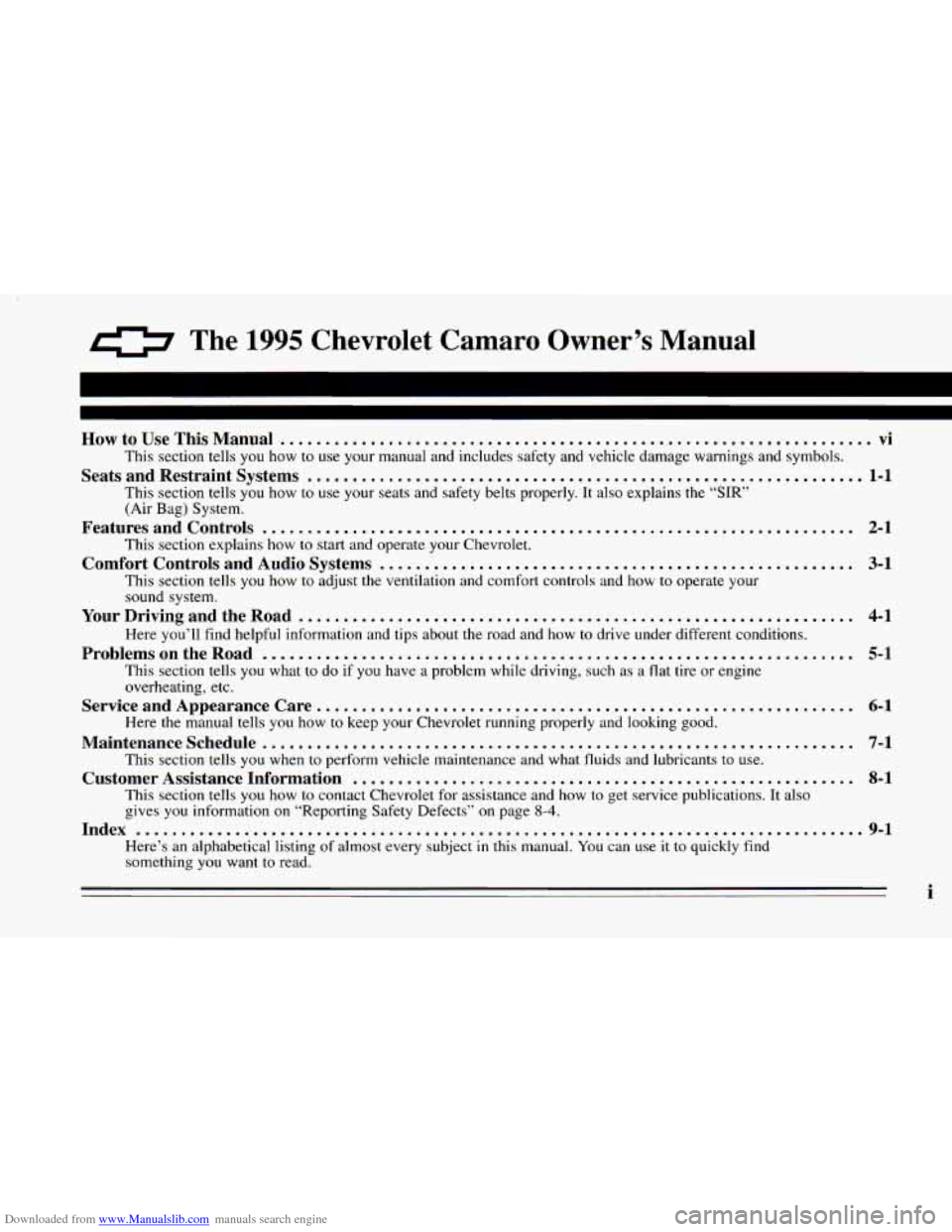
Downloaded from www.Manualslib.com manuals search engine 0 The 1995 Chevrolet Carnaro Owner’s Manual
How to Use This Manual .................................................................. vi
Seats and Restraint Systems .............................................................. 1-1
This section tells you how to use your manual and includes safety and vehicle damage warnings and symbols.
This section tells you how to use your seats and safety belts properly.
It also explains the “SIR”
(Air Bag) System.
This section explains how to start and operate your Chevrolet.
This section tells you how to adjust the ventilation and comfort controls and how to operate your
sound system.
Here you’ll find helpful information and tips about the road and how to drive under different conditions.
This section tells you what
to do if you have a problem while driving, such as a flat tire or engine
overheating, etc.
Here the manual tells you how to keep your Chevrolet running properly and looking good.
This section tells
you when to perform vehicle maintenance and what fluids and lubricants to use.
This section tells you how to contact Chevrolet for assistance and how to get service publications. It
also
gives you information on “Reporting Safety Defects” on page 8-4.
Here’s an alphabetical listing of almost every subject in this manual. You can use it to quickly find
something you want
to read.
Features and Controls .................................................................. 2-1
Comfort Controls and Audio Systems ..................................................... 3-1
YourDrivingandtheRoad .............................................................. 4-1
ProblemsontheRoad .................................................................. 5-1
ServiceandAppearanceCare ............................................................ 6-1
Maintenanceschedule.............. .................................................... 7-1
Customer Assistance Information ........................................................ 8-1
Index ........................................................................\
......... 9-1
i
Page 125 of 388
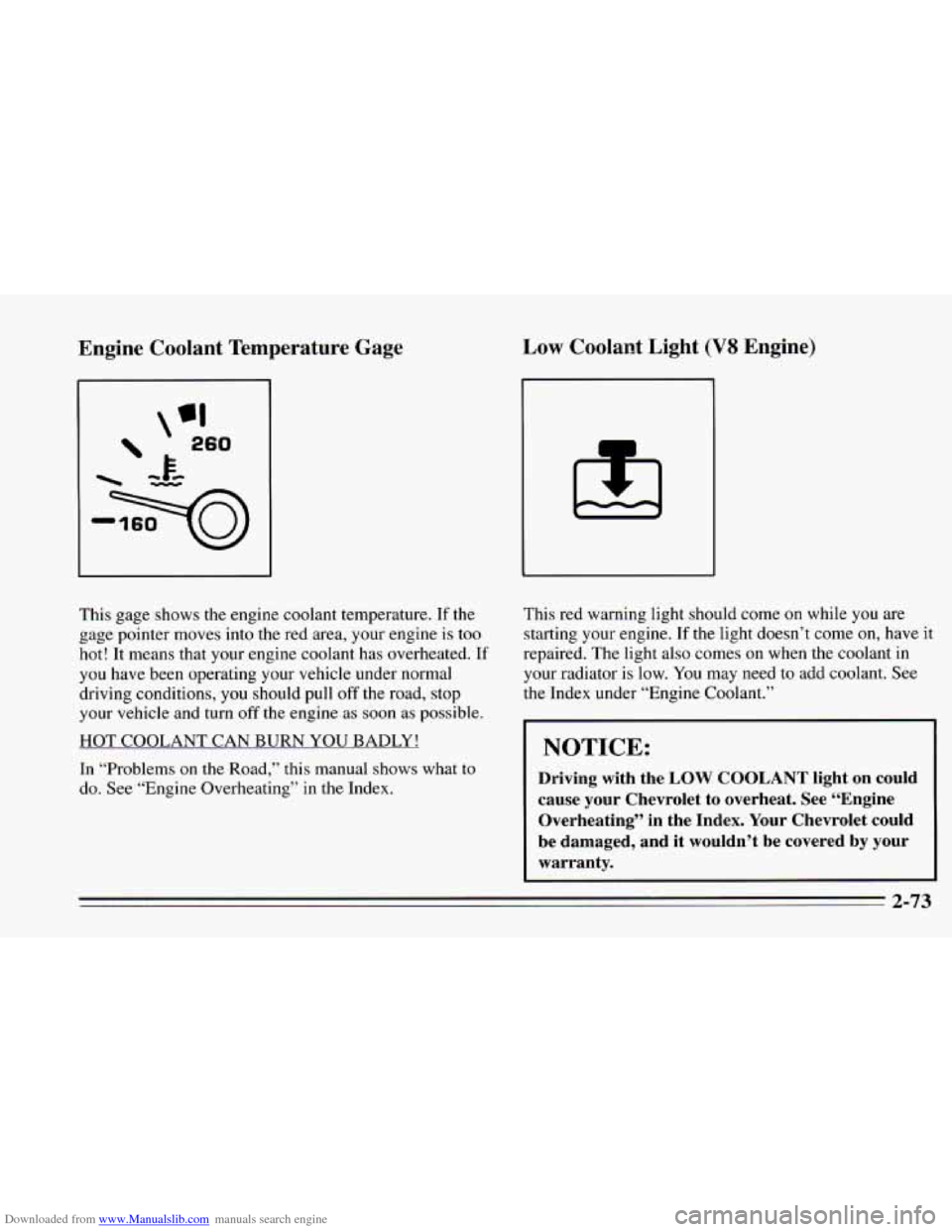
Downloaded from www.Manualslib.com manuals search engine Engine Coolant Temperature Gage Low Coolant Light (V8 Engine)
This gage shows the engine coolant temperature. If the
gage pointer moves into the red area, your engine is too
hot! It means that your engine coolant has overheated.
If
you have been operating your vehicle under normal
driving conditions, you should pull
off the road, stop
your vehicle and turn
off the engine as soon as possible.
HOT COOLANT CAN BURN YOU BADLY!
In “Problems
on the Road,” this manual shows what to
do. See “Engine Overheating” in the Index. This
red warning light should
come on while you are
starting your engine.
If the light doesn’t come on, have it
repaired. The light also comes on when the coolant in
your radiator is low. You may need to add coolant. See
the Index under “Engine Coolant.”
NOTICE:
Driving with the LOW COOLANT light on could
cause your Chevrolet to overheat. See “Engine
Overheating’’ in the Index. Your Chevrolet could
be damaged, and it wouldn’t be covered by your
warranty.
2-73
Page 130 of 388
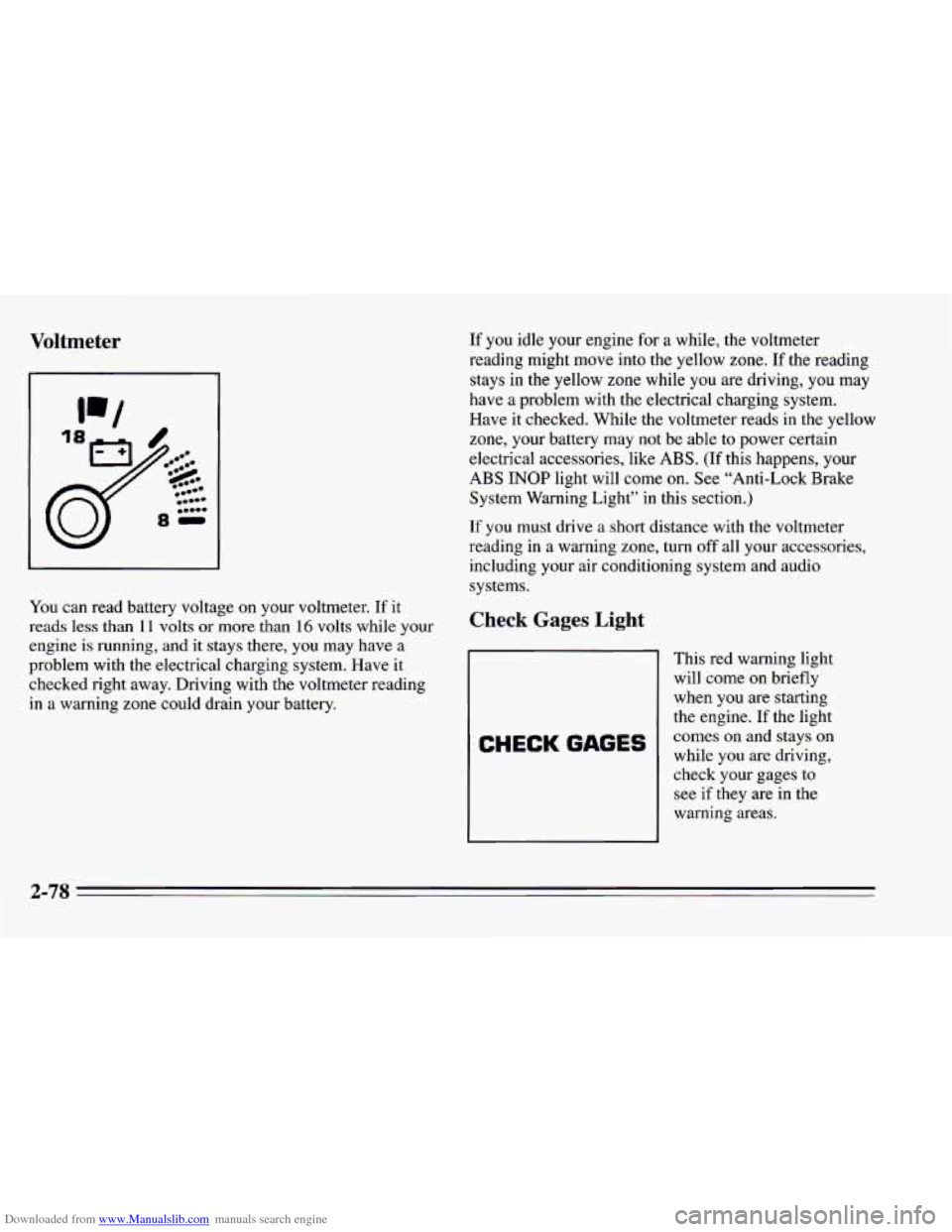
Downloaded from www.Manualslib.com manuals search engine Voltmeter
You can read battery voltage on your voltmeter. If it
reads less than
11 volts or more than 16 volts while your
engine is running, and
it stays there, you may have a
problem with the electrical charging system. Have it
checked right away. Driving with the voltmeter reading
in a warning zone could drain your battery.
If you idle your engine for a while, the voltmeter
reading might move into the yellow zone.
If the reading
stays in the yellow zone while you are driving, you may
have a problem with the electrical charging system.
Have it checked. While the voltmeter reads in the yellow
zone, your battery may
not be able to power certain
electrical accessories, like ABS.
(If this happens, your
ABS INOP light will come on. See “Anti-Lock Brake
System Warning Light” in this section.)
If you must drive a short distance with the voltmeter
reading in a warning zone, turn
off all your accessories,
including your air conditioning system and audio
systems.
Check Gages Light
CHECK GAGES
This red warning light
will come
on briefly
when you are starting
the engine.
If the light
comes on and stays on
while you are driving,
check your gages to
see if they are in the
warning areas.
2-78
Page 139 of 388
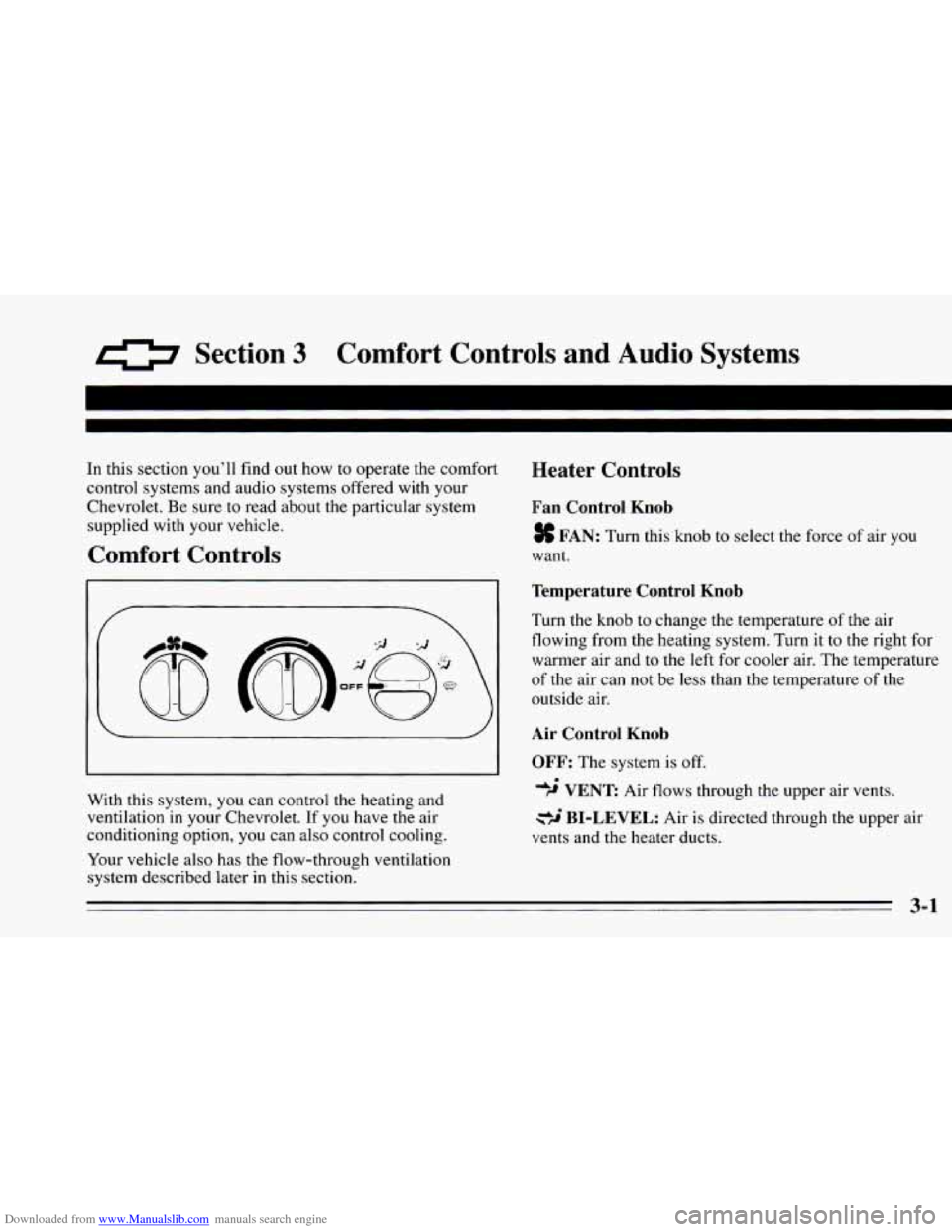
Downloaded from www.Manualslib.com manuals search engine 0 Section 3 Comfort Controls and Audio Systems
In this section you'll find out how to operate the comfort
control systems and audio systems offered with your
Chevrolet. Be sure to read about the particular system
supplied with your vehicle.
Comfort Controls
Heater Controls
Fan Control Knob
$$ FAN: Turn this knob to select the force of air you
want.
With this system,
you can control the heating and
ventilation
in your Chevrolet. If you have the air
conditioning option, you can also control cooling.
Your vehicle also has the flow-through ventilation
system described later
in this section.
Temperature Control Knob
Turn the knob to change the temperature of the air
flowing from the heating system. Turn it
to the right for
warmer air and to the left for cooler air. The temperature
of the air can not be less than the temperature of the
outside air.
Air Control Knob
OFF:
The system is off.
4' # VENT: Air flows through the upper air vents.
BI-LEVEL: Air is directed through the upper air
vents and the heater ducts.
3-1
Page 141 of 388
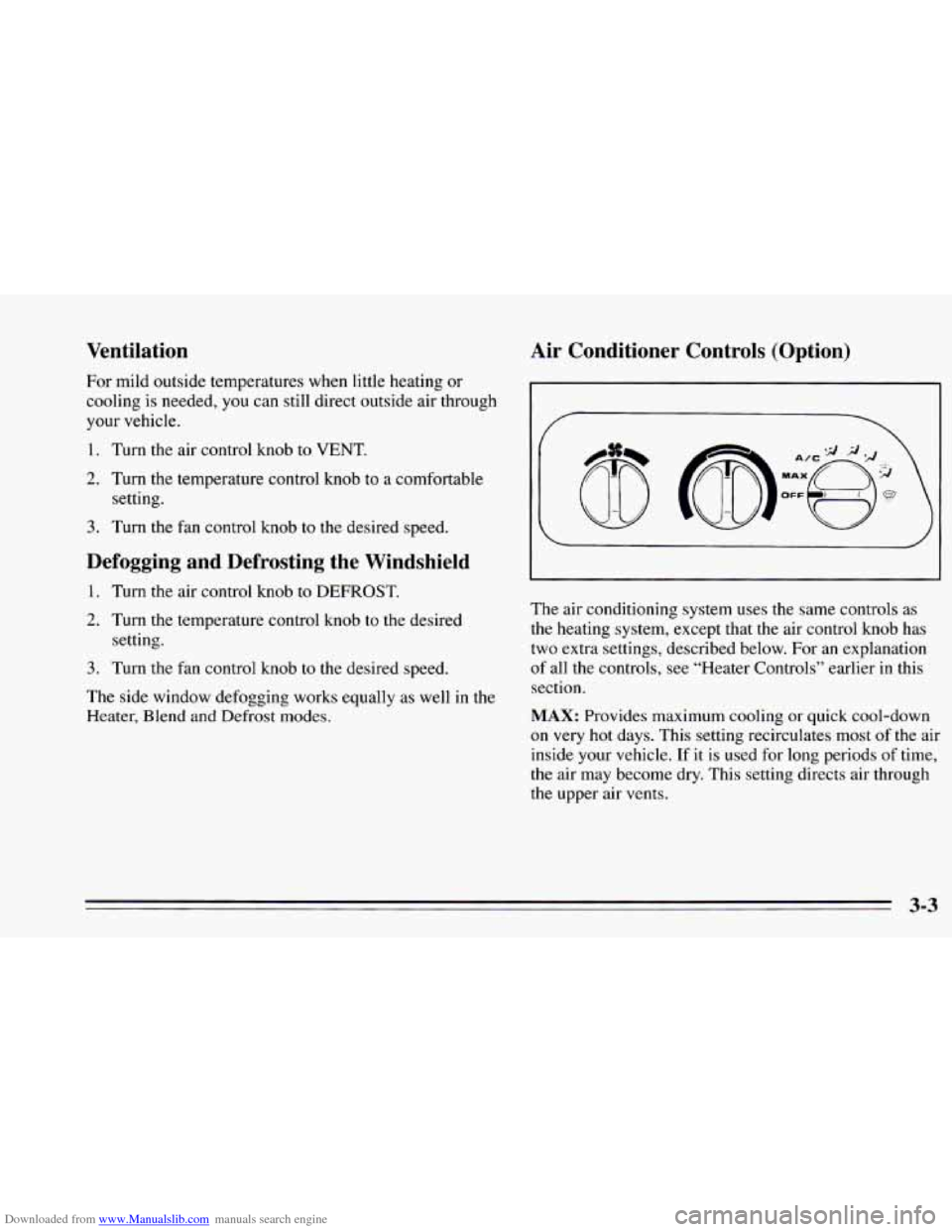
Downloaded from www.Manualslib.com manuals search engine Ventilation
For mild outside temperatures when little heating or
cooling is needed, you can still direct outside air through
your vehicle.
1. Turn the air control knob to VENT.
2. Turn the temperature control knob to a comfortable
3. Turn the fan control knob to the desired speed.
Defogging and Defrosting the Windshield
1. Turn the air control knob to DEFROST.
2. Turn the temperature control knob to the desired
setting.
setting.
3. Turn
the fan control knob to the desired speed.
The side window defogging works equally as well
in the
Heater, Blend and Defrost modes.
Air Conditioner Controls (Option)
The air conditioning system uses the same controls as
the heating system, except that the air control knob has
two extra settings, described below. For an explanation
of all the controls, see “Heater Controls’’ earlier in this
section.
MAX: Provides maximum cooling or quick cool-down
on very hot days.
This setting recirculates most of the air
inside your vehicle. If it is used for long periods of time,
the air may become dry. This setting directs air through
the upper air vents.
3-3
Page 142 of 388
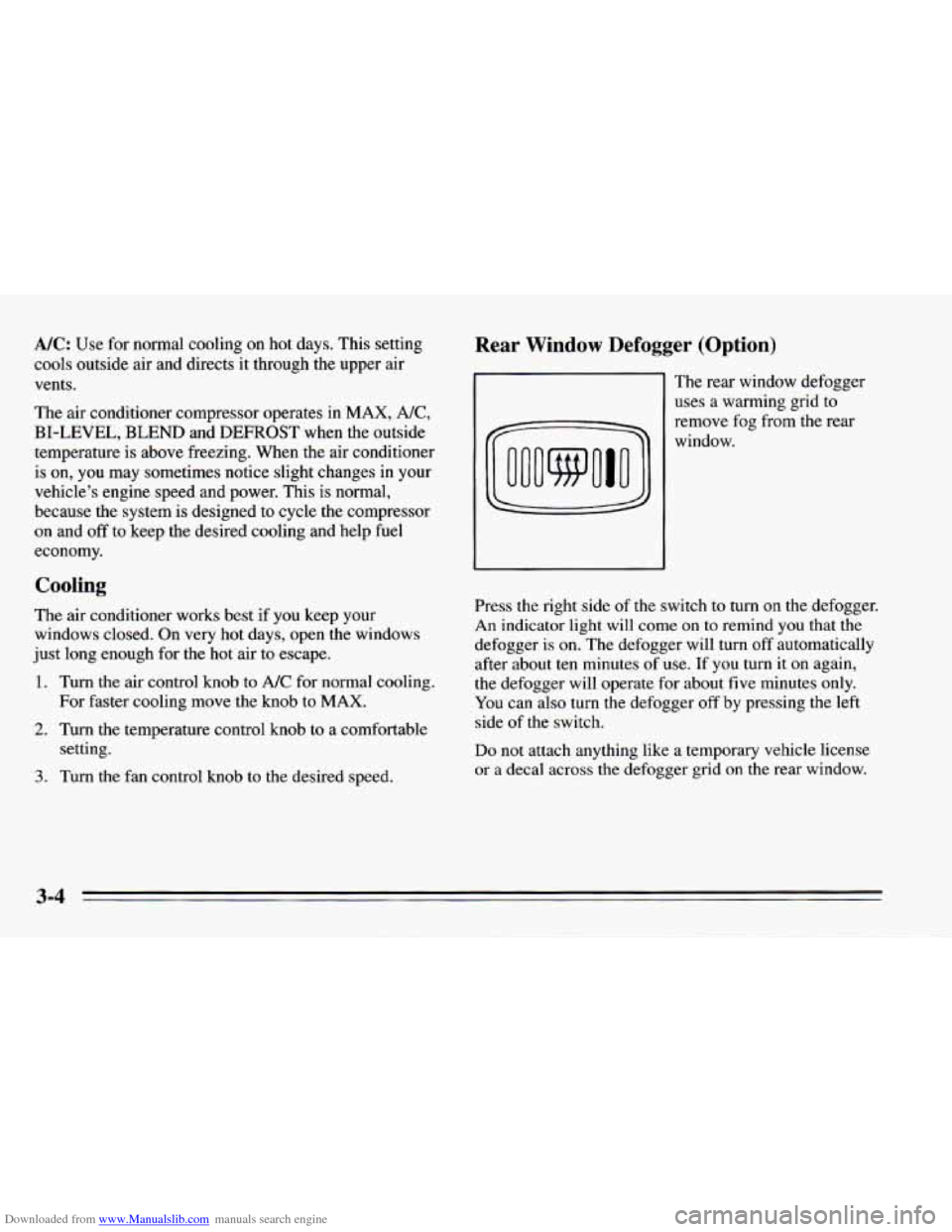
Downloaded from www.Manualslib.com manuals search engine A/C: Use for normal cooling on hot days. This setting
cools outside air and directs it through the upper air
vents.
The air conditioner compressor operates in
MAX, NC,
BI-LEVEL, BLEND and DEFROST when the outside
temperature
is above freezing. When the air conditioner
is on, you may sometimes notice slight changes in your
vehicle’s engine speed and power. This is normal,
because the system is designed to cycle the compressor
on and
off to keep the desired cooling and help fuel
economy.
Cooling
The air conditioner works best if you keep your
windows closed. On very hot days, open the windows
just long enough for the hot air to escape.
1. Turn the air control knob to A/C for normal coolinn.
For faster cooling move the knob to
MAX.
setting.
2. Turn the temperature control knob to a comfortable
3. Turn the fan control knob to the desired speed.
Rear Window Defogger (Option)
The rear window defogger
uses a warming grid to
remove fog
from the rear
window.
Press the right side of the switch to turn
on the defogger.
An indicator light will come on to remind you that the
defogger is on. The defogger will
turn off automatically
after about ten minutes of use.
If you turn it on again,
the defogger will operate for about five minutes only.
You can also turn the defogger
off by pressing the left
side of the switch.
Do not attach anything like a temporary vehicle license
or a decal across the defogger grid on the rear window.
3-4
Page 208 of 388
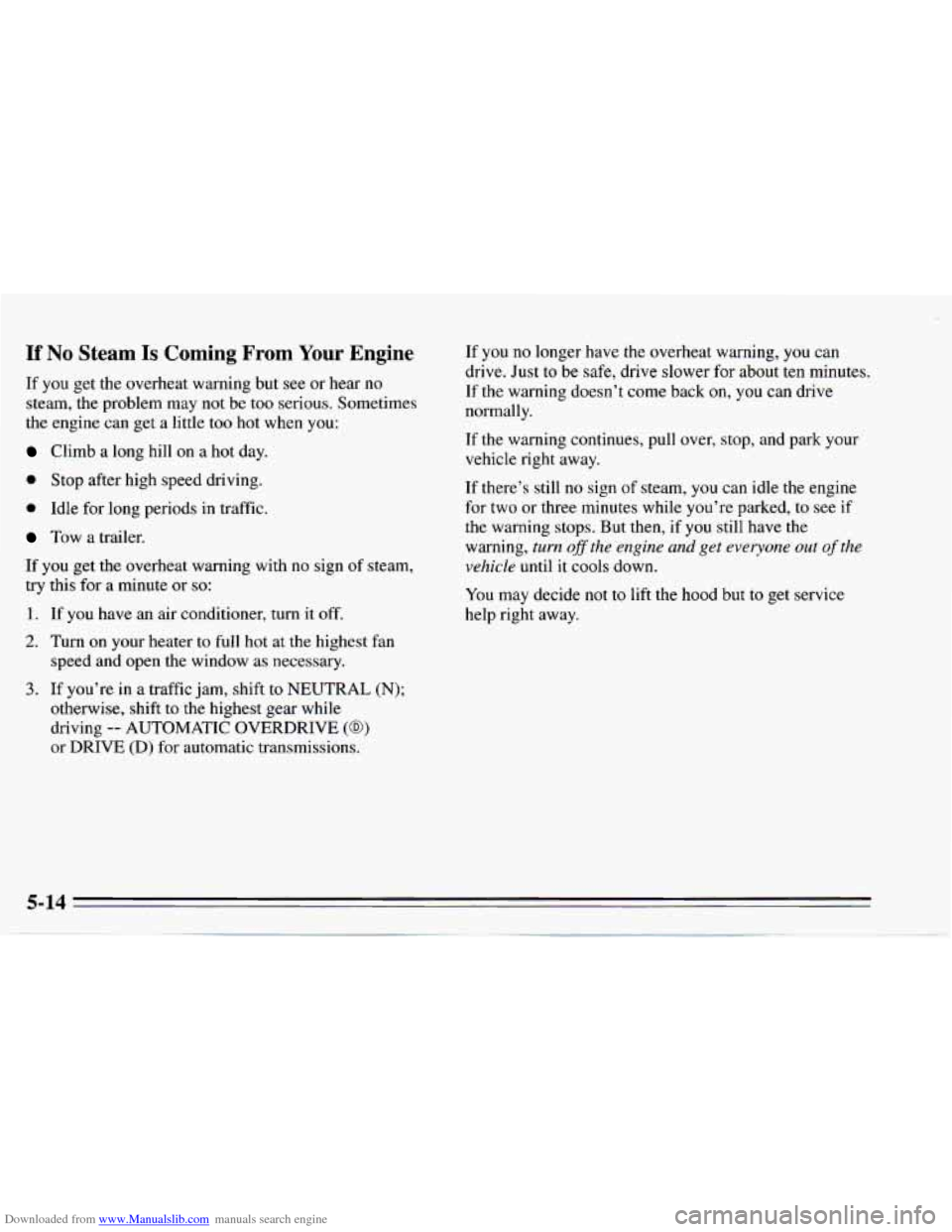
Downloaded from www.Manualslib.com manuals search engine If No Steam Is Coming From Your Engine
If you get the overheat warning but see or hear no
steam, the problem may not be
too serious. Sometimes
the engine can get a little too hot when you:
Climb a long hill on a hot day.
0 Stop after high speed driving.
0 Idle for long periods in traffic.
Tow a trailer.
If you get the overheat warning with no sign
of steam,
try this for a minute or
so:
1. If you have an air conditioner, turn it off.
2. Turn on your heater to full hot at the highest fan
speed and open the window as necessary.
3. If you’re in a traffic jam, shift to NEUTRAL (N);
otherwise, shift to the highest gear while
driving
-- AUTOMATIC OVERDRIVE (a)
or DRIVE (D) for automatic transmissions. If you
no longer
have the overheat warning, you can
drive. Just
to be safe, drive slower for about ten minutes.
If the warning doesn’t come back
on, you can drive
normally.
If the warning continues, pull over, stop, and park your
vehicle right away.
If there’s still no sign
of steam, you can idle the engine
for two or three minutes while you’re parked,
to see if
the warning stops. But then, if you still have the
warning,
turn ofSthe engine and get everyone out of the
vehicle
until it cools down.
You may decide not to lift the hood but to get service
help right away.
Page 288 of 388
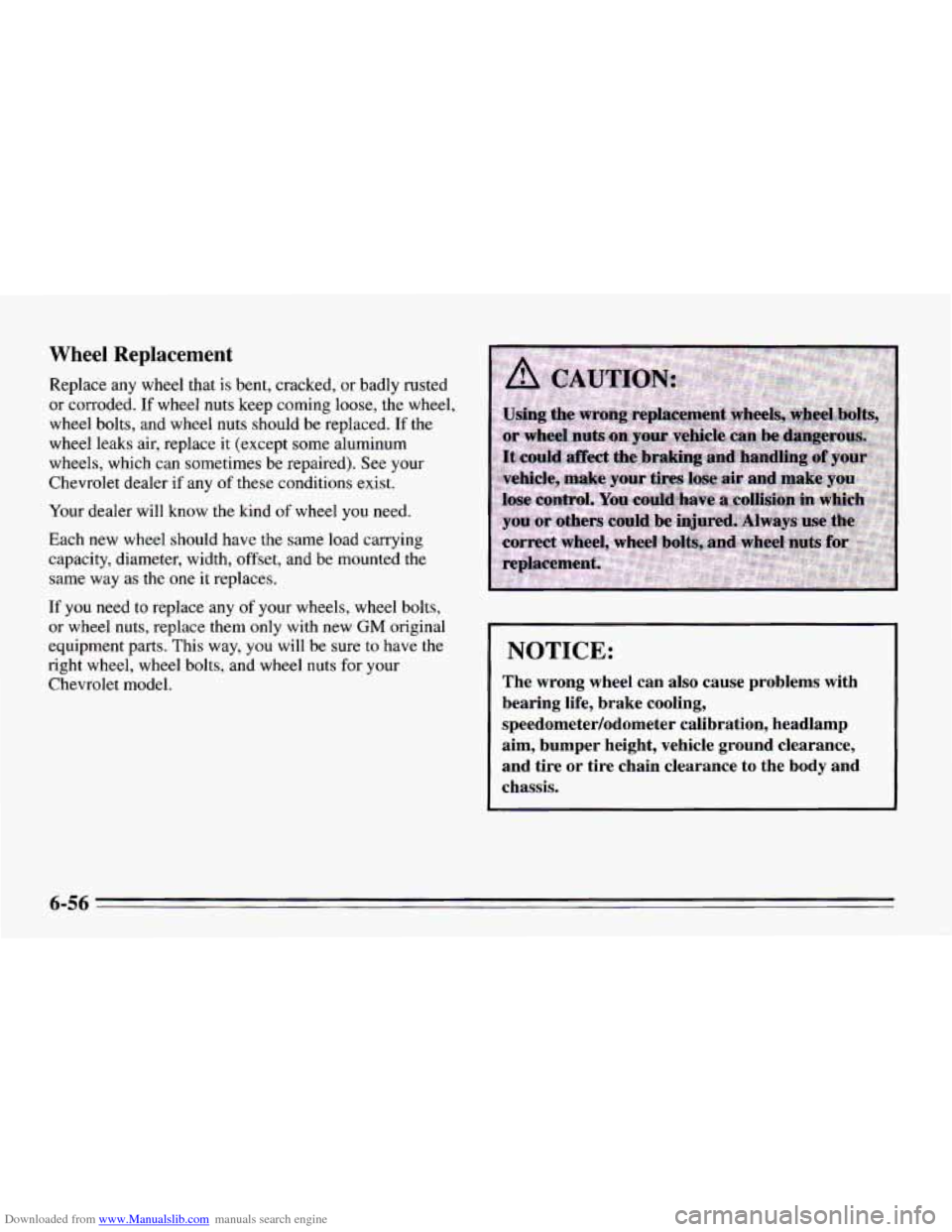
Downloaded from www.Manualslib.com manuals search engine Wheel Replacement
Replace any wheel that is bent, cracked, or badly rusted
or corroded. If wheel nuts keep coming loose, the wheel,
wheel bolts, and wheel nuts should be replaced. If the
wheel leaks air, replace it (except some aluminum
wheels, which can sometimes be repaired). See your
Chevrolet dealer if any
of these conditions exist.
Your dealer will know the kind
of wheel you need.
Each new wheel should have the same load carrying
capacity, diameter, width, offset, and be mounted the
same way as the one it replaces.
If you need
to replace any of your wheels, wheel bolts,
or wheel
nuts, replace them only with new GM original
equipment parts. This way,
you will be sure to have the
right wheel, wheel bolts, and wheel nuts
for your
Chevrolet model. I NOTICE:
The wrong wheel can also cause problems with
bearing life, brake cooling,
speedometerlodometer calibration, headlamp
aim, bumper height, vehicle ground clearance,
I and tire or tire chain clearance to the body and
chassis.
6-56